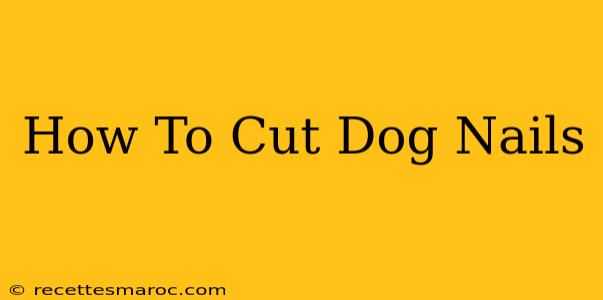Clipping your dog's nails might seem daunting, but it's a crucial part of pet care. Overgrown nails can cause discomfort, joint problems, and even affect their gait. This comprehensive guide will walk you through the process, helping you trim your dog's nails safely and effectively at home.
Preparing for the Nail Trimming Process
Before you even grab the clippers, preparation is key. A stressed dog is more likely to struggle, making the experience unpleasant for both of you.
1. Gather Your Supplies:
- Nail clippers: Choose clippers specifically designed for dogs. Guillotine-style clippers or scissor-style clippers are both popular choices. Experiment to see which type you find easiest to use.
- Styptic powder: This is essential! It stops bleeding quickly if you accidentally cut the quick (the pink part of the nail containing blood vessels and nerves).
- Treats: High-value treats are your best friend. Positive reinforcement is crucial for a successful nail trim.
- Towel: A towel can help restrain your dog gently if needed.
- Flashlight (optional): This can help you see the quick more clearly, especially in dark-colored nails.
2. Get Your Dog Comfortable:
- Choose the right time: Pick a time when your dog is calm and relaxed. Avoid doing it when they're tired, hungry, or overly excited.
- Positive associations: Start by gently touching your dog's paws regularly, rewarding them with treats. This helps them get used to having their paws handled.
- Make it a positive experience: Keep the sessions short and sweet, especially in the beginning. End on a positive note, even if you only manage to trim one or two nails.
How to Cut Dog Nails: A Step-by-Step Guide
Now, let's get down to the actual trimming. Remember, patience is key.
1. Examine the Nail:
Carefully inspect each nail. Identify the quick – the pink part of the nail. Avoid cutting into the quick, as this will cause bleeding and pain. The quick is usually easier to see in lighter-colored nails. In darker nails, you might only see a small portion of the quick. It’s better to err on the side of caution and cut less.
2. The Cutting Technique:
- Guillotine clippers: Insert the nail into the guillotine and squeeze the handles firmly.
- Scissor clippers: Place the clippers just above the quick and make a clean, swift cut.
Important Tip: It’s generally recommended to cut small amounts at a time, especially if you’re unsure about the quick's location. It's always better to trim a little and then reassess rather than risk cutting too much off.
3. Reward Your Dog:
Immediately reward your dog with praise and treats after each nail is trimmed. This reinforces positive behavior and makes future nail trims easier.
4. Dealing with Bleeding:
If you accidentally cut the quick, don't panic. Immediately apply styptic powder to the bleeding nail. Hold it in place until the bleeding stops.
Different Nail Types & Considerations
Not all dog nails are created equal. Understanding your dog's nail type can aid in successful trimming.
- Thick Nails: These might require more effort and potentially more frequent trimming.
- Delicate Nails: Exercise extra caution with these nails, trimming very small amounts at a time.
- Dark Nails: Using a flashlight can help you visualize the quick more easily.
- Long Nails: If your dog’s nails are extremely long, it may be best to consult a professional groomer for the initial trimming. This is especially important if you're uncomfortable or unsure about cutting into the quick.
When to Seek Professional Help
While trimming your dog’s nails at home is achievable, there are times when professional help is necessary:
- Extremely nervous or aggressive dogs: A professional groomer has the experience and techniques to handle anxious or aggressive dogs safely.
- Dogs with medical conditions: If your dog has any nail or paw-related medical conditions, consult your veterinarian.
- You are uncomfortable: If you feel uncomfortable or unsure about trimming your dog's nails, don't hesitate to seek help from a groomer or veterinarian.
Trimming your dog's nails is an essential part of responsible pet ownership. By following these steps and prioritizing safety and patience, you can ensure your canine companion stays comfortable and healthy. Remember, consistency is key – regular trimming prevents overgrown nails and keeps your dog happy and healthy.

